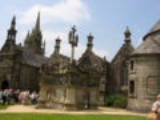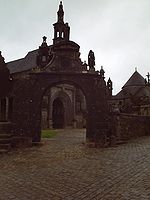
Guimiliau
Encyclopedia
Guimiliau is a commune
in the Finistère
department of Brittany in north-western France
.
It is noted for its parish
close
. It should not be confused with the neighbouring commune and village of Lampaul-Guimiliau
.
Guimiliens.
, is named after St Miliau. The name simply means town or settlement (Breton: gwic) of Milio. According to legend, Miliau was a good and just Breton prince, put to death in a dynastic quarrel in the 6th or 9th century.
Guimiliau is also famous as the reputed birth place of St Hervé, a 6th century ascetic, who is one of the most popular Breton saints.
 Parish
Parish
closes
are a distinctive feature of Breton culture in the historic Léon diocese
, in which Guimiliau stands. As the name suggests, a close is a completely enclosed church yard, usually with a commanding entrance arch. Sacred enclosures were a feature of Celtic religion even before the arrival of Christianity. Parish closes today form the foci for pardons
, the annual Breton pilgrimage festivals, which can attract thousands of worshippers.
The parish close of Guimiliau is situated at the upper end of the main village street, with the entrance dominating the village.
The calvary
or crucifix
is the centre piece of the church yard, surrounded by a fine and complex retelling of the Passion
in statuary.
The church contains many fine examples of polychrome
sculpture from the sixteenth century onwards, including several large retable
s. There is also a fine octagonal baptistery
, a carved pulpit
and a collection of banner
s used especially in religious processions at pardons
.
Communes of France
The commune is the lowest level of administrative division in the French Republic. French communes are roughly equivalent to incorporated municipalities or villages in the United States or Gemeinden in Germany...
in the Finistère
Finistère
Finistère is a département of France, in the extreme west of Brittany.-History:The name Finistère derives from the Latin Finis Terræ, meaning end of the earth, and may be compared with Land's End on the opposite side of the English Channel...
department of Brittany in north-western France
France
The French Republic , The French Republic , The French Republic , (commonly known as France , is a unitary semi-presidential republic in Western Europe with several overseas territories and islands located on other continents and in the Indian, Pacific, and Atlantic oceans. Metropolitan France...
.
It is noted for its parish
Parish
A parish is a territorial unit historically under the pastoral care and clerical jurisdiction of one parish priest, who might be assisted in his pastoral duties by a curate or curates - also priests but not the parish priest - from a more or less central parish church with its associated organization...
close
Parish close
Parish close is a translation of the French term enclos paroissial. It refers to a number of locations Brittany, mainly though not exclusively in the historic diocese of Léon, corresponding roughly to the northern half of the département of Finistère, in Brittany...
. It should not be confused with the neighbouring commune and village of Lampaul-Guimiliau
Lampaul-Guimiliau
Lampaul-Guimiliau is a commune in the Finistère department of Brittany in northwestern France.It is noted for its parish close.-Etymology:...
.
Population
Inhabitants of Guimiliau are called in FrenchFrench language
French is a Romance language spoken as a first language in France, the Romandy region in Switzerland, Wallonia and Brussels in Belgium, Monaco, the regions of Quebec and Acadia in Canada, and by various communities elsewhere. Second-language speakers of French are distributed throughout many parts...
Guimiliens.
Local Saints
Guimiliau, or Gwimilio in BretonBreton language
Breton is a Celtic language spoken in Brittany , France. Breton is a Brythonic language, descended from the Celtic British language brought from Great Britain to Armorica by migrating Britons during the Early Middle Ages. Like the other Brythonic languages, Welsh and Cornish, it is classified as...
, is named after St Miliau. The name simply means town or settlement (Breton: gwic) of Milio. According to legend, Miliau was a good and just Breton prince, put to death in a dynastic quarrel in the 6th or 9th century.
Guimiliau is also famous as the reputed birth place of St Hervé, a 6th century ascetic, who is one of the most popular Breton saints.
Parish close

Parish
A parish is a territorial unit historically under the pastoral care and clerical jurisdiction of one parish priest, who might be assisted in his pastoral duties by a curate or curates - also priests but not the parish priest - from a more or less central parish church with its associated organization...
closes
Parish close
Parish close is a translation of the French term enclos paroissial. It refers to a number of locations Brittany, mainly though not exclusively in the historic diocese of Léon, corresponding roughly to the northern half of the département of Finistère, in Brittany...
are a distinctive feature of Breton culture in the historic Léon diocese
Diocese
A diocese is the district or see under the supervision of a bishop. It is divided into parishes.An archdiocese is more significant than a diocese. An archdiocese is presided over by an archbishop whose see may have or had importance due to size or historical significance...
, in which Guimiliau stands. As the name suggests, a close is a completely enclosed church yard, usually with a commanding entrance arch. Sacred enclosures were a feature of Celtic religion even before the arrival of Christianity. Parish closes today form the foci for pardons
Pardon (ceremony)
A Pardon is a typically Breton form of pilgrimage and one of the most traditional demonstrations of popular Catholicism in Brittany. Of very ancient origin, probably dating back to the conversion of the country by the Celtic monks, it is comparable to the parades associated with Saint Patrick's Day...
, the annual Breton pilgrimage festivals, which can attract thousands of worshippers.
The parish close of Guimiliau is situated at the upper end of the main village street, with the entrance dominating the village.
The calvary
Calvary
Calvary or Golgotha was the site, outside of ancient Jerusalem’s early first century walls, at which the crucifixion of Jesus is said to have occurred. Calvary and Golgotha are the English names for the site used in Western Christianity...
or crucifix
Crucifix
A crucifix is an independent image of Jesus on the cross with a representation of Jesus' body, referred to in English as the corpus , as distinct from a cross with no body....
is the centre piece of the church yard, surrounded by a fine and complex retelling of the Passion
Passion (Christianity)
The Passion is the Christian theological term used for the events and suffering – physical, spiritual, and mental – of Jesus in the hours before and including his trial and execution by crucifixion...
in statuary.
The church contains many fine examples of polychrome
Polychrome
Polychrome is one of the terms used to describe the use of multiple colors in one entity. It has also been defined as "The practice of decorating architectural elements, sculpture, etc., in a variety of colors." Polychromatic light is composed of a number of different wavelengths...
sculpture from the sixteenth century onwards, including several large retable
Retable
A retable is a framed altarpiece, raised slightly above the back of the altar or communion table, on which are placed the cross, ceremonial candlesticks and other ornaments....
s. There is also a fine octagonal baptistery
Baptistery
In Christian architecture the baptistry or baptistery is the separate centrally-planned structure surrounding the baptismal font. The baptistry may be incorporated within the body of a church or cathedral and be provided with an altar as a chapel...
, a carved pulpit
Pulpit
Pulpit is a speakers' stand in a church. In many Christian churches, there are two speakers' stands at the front of the church. Typically, the one on the left is called the pulpit...
and a collection of banner
Banner
A banner is a flag or other piece of cloth bearing a symbol, logo, slogan or other message. Banner-making is an ancient craft.The word derives from late Latin bandum, a cloth out of which a flag is made...
s used especially in religious processions at pardons
Pardon (ceremony)
A Pardon is a typically Breton form of pilgrimage and one of the most traditional demonstrations of popular Catholicism in Brittany. Of very ancient origin, probably dating back to the conversion of the country by the Celtic monks, it is comparable to the parades associated with Saint Patrick's Day...
.

